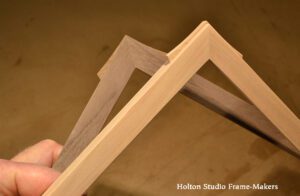This is a classic California impressionist painting by British-born Frank Montague Moore (1877-1967), painted in the 1920’s. The oil painting, which is 12″ x 16″, is set in a 2-1/2″ wide stained quarter sawn white oak frame is our No. 308.0 profile—a simple scoop with a bead near the sight edge, and has a 23 kt gilt slip. Framed for and offered by California Historical Design.
 Forty-one of Moore’s paintings are very handsomely framed by the historic bridge at the Langham Huntington Hotel in Pasadena. The so-called “picture bridge” was restored a few years ago. One of the paintings, shown at right as featured on a postcard, includes eucalyptus trees Moore treated in a similar manner to those in the painting above. More images of the bridge are below—the first image showing the bridge today, and two more period postcards.
Forty-one of Moore’s paintings are very handsomely framed by the historic bridge at the Langham Huntington Hotel in Pasadena. The so-called “picture bridge” was restored a few years ago. One of the paintings, shown at right as featured on a postcard, includes eucalyptus trees Moore treated in a similar manner to those in the painting above. More images of the bridge are below—the first image showing the bridge today, and two more period postcards.
From Wikipedia:
Frank Montague Moore was born November 24, 1877, in Taunton, England, and studied at the Liverpool Art School and the Royal Institute. He immigrated to the United States and took additional painting lessons from Henry Ward Ranger. In 1910, he moved from New York City to Hawaii, where he worked as a purchasing agent for Hawaii Plantations.[2] He became the first director of the Honolulu Museum of Art in 1924, but resigned in 1927, shortly before the museum opened.[3]
In 1928, he left Hawaii for California, where he painted 41 murals collectively known as the Picture Bridge for the Huntington Hotel in Pasadena and many easel paintings of California landscapes.[4] Moore died in Carmel, California, on March 5, 1967.[5]
Again, this lovely painting is available from California Historical Design.






















































